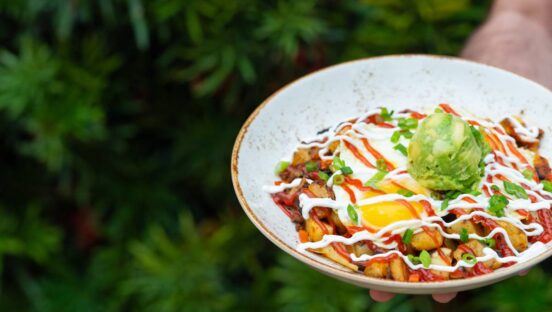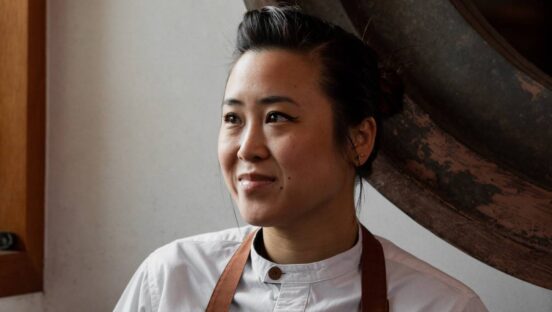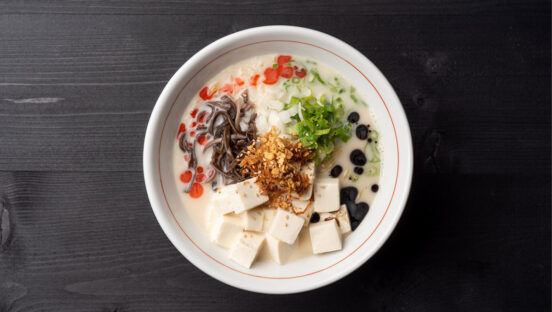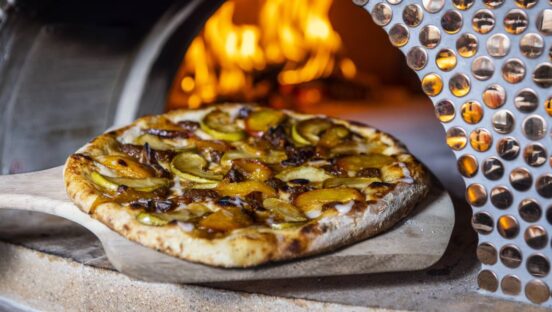










Chicago
Established: 2017
Owner: BDG Hospitality and 8 Hospitality Partnership
Chef: Mark Sparacino
How they do it: LiqrBox burst onto Chicago’s dining scene just ahead of the stroke of midnight this past New Year’s Eve. It’s a fitting start to a three-level concept that’s part restaurant, part nightclub, and total millennial bait. Neon lights and funky murals set the stage for throwback libations and foods like Spaghetti Ohhhh’s, PB&J, and a Taste the Rainbow six-pack composed of adult juice boxes.
Steal it: Find where the business goals align with the customer’s—that’s the sweet spot.
Houston, Texas
Established: 2018
Owner: John Reed, Leslie Nguyen, Vinnie Capizzi, and additional managing partners
Chef: Executive Chef Peter Petro, Head Chef Jeff Fernandez
How they do it: Just six months into its operation, BCK: Kitchen & Cocktail Adventures stays true to its name. The menu is an adventure back to childhood, but through a slightly international lens. The owners took American classics and re-envisioned them with better quality products and made them colorful for social media purposes. Comfort foods like Shaked+Baked Pork Chops and Mac n’ Cheez-It share space with Vietnamese Pot Pie and Peking Duck Tacos. But the cocktails are where BCK truly shines: Berry Crunch Milk Punch combines Buffalo Trace with Captain Crunch–soaked milk and strawberries and Dr. Feelgood blends Jack Rye, Dr. Pepper, Orgeat, citrus, and bitters.
Steal it: The owners of BCK emphasize that it’s important to build a concept based around an unmet need—not what one person alone wants. Nevertheless looking to childhood favorites as the founders of BCK did, doesn’t hurt. As they put it, nostalgia is an element that everyone can appreciate.
Nashville
Established: 2016
Owner: Sarah and Brad Gavigan
Chef: Andrew Rodriguez
How they do it: Little Octopus was first established as a full-service pop-up inside POP, a restaurant incubator space on the second floor of an otherwise nondescript two-story strip mall in East Nashville. When it came time to graduate to its own brick and mortar in 2017, owners Sarah and Brad Gavigan pulled out all the stops with Los Angeles design firm Design, Bitches. The result? A fully ‘grammable space. “In our concept, food and design are partners in making the restaurant taste and feel fantastic,” Sarah Gavigan says. “After all we eat with our eyes.”
Steal it: Make sure the food matches the design. Gavigan says Little Octopus had some growing pains after the start-studded, Hollywood-style design set a new bar. “Never underestimate the time and energy a new restaurant needs in the first two years,” she says.
San Pedro, California
Established: 1956
Founder/president: Thomas Amalfitano
CEO: Michael Ungaro
How they do it: A restaurant still going strong after 60 years can be called many things—established, enduring, adaptable—but it’s rarely described as trendy. But for family-founded and owned San Pedro Fish Market, that’s exactly the case; last year it even made Food & Wine’s 10 most Instagrammed restaurants list.
In 2007, the family-founded and owned concept experienced its first dip in sales that couldn’t be attributed to rainy weather. “To combat this I invented a marketing strategy to tell our story, something we’d never done before. As a matter of fact, we had zero invested in marketing or advertising prior to this,” says CEO Michael Ungaro. Using Facebook primarily and later Instagram, San Pedro Fish Market released its very own behind-the-scenes web series, www.KingsofFishTV.com, which continues to be an internet sensation.
Steal it: Even successful legacy concepts can benefit from shaking things up, whether it be through introducing a new component to the business as San Pedro Fish Market did, experimenting with new dishes, or sprucing up the design. But such updates should never come at the expense of being genuine. “One of the big buzzwords in the restaurant industry today is authenticity, and I don’t think it’s been very well defined yet. But consumers know when something is not authentic,” says Ungaro, who uses narratives to communicate authenticity. “People love stories, and if you can make them part of the story that is your restaurant … they will happily tell your stories for you.”
San Antonio, Texas
Established: 2017
Owner: Fat Dachshund Inc.
Chef: Vinh Hoang
How they do it: Nothing quite captures the eternal spirit of youthful insolence than a name like Suck It—and co-owners Vinh Hoang and Yen Nguyen know it. “Who’s attention would not get caught with the name, Suck It?” Hoang says. Still, it’s not an entirely random moniker; the concept started as a hookah and bubble tea joint before evolving into a full-service venture. That playful, if not slightly subversive, character extends to the menu. “I like to take everyday food that people are comfortable with and put a twist to it. For example, I like barbacoa tacos (a Mexican dish) and beef pho (a Vietnamese dish.) What did I do? I combined both and made a barbacoa pho. They’re both beef based and the fusion between the two created an amazing flavor that complemented each other. But without a doubt, the most Instagrammable elements of Suck It are its vast assortment of bubble tea smoothies in unexpected mash-ups including Red Velvet Ghirardelli White Chocolate and Taro Coconut. These brightly hued drinks are then overloaded with the likes of whipped cream, cereal, macarons, mini doughnuts, and chocolate-dipped pretzel sticks.
Steal it: Aside from Hoang urging aspiring restaurateurs to not open a restaurant, he says that if they do decide to take the plunge, “Be sure to have fun with it.” Suck It’s fun-loving attitude is in line with its fusion savories and excessive dessert smoothies. All in all, it’s hit a sweet spot with the clientele.
Cincinnati, Ohio
Established: 2016
Owner: Ryan Santos
Chef: Ryan Santos
Pastry chef: Sarah Todd
How they do it: It will come as no surprise that before Chef Ryan Santos realized his culinary dreams, he studied graphic design. At Please, the dishes—made with local ingredients, often foraged or grown in an urban garden—appear as if plucked from a minimalist art exhibit. The 30-seat dining space plus open kitchen sports a similarly crisp motif—save for the bathroom. “One of the unexpected mistakes was our bathroom, which has become an Instagram sensation in its own right,” Santos says. Indeed, the bathroom with its Miró–style tiling led to a good deal of #PleasePotty posting.
Steal it: Rather than bait the ever-elusive millennial with looks alone, focus on quality. Santos wasn’t gunning for social media stardom; it was simply a natural byproduct of his creativity. “While I would say we certainly appeal to millennials aesthetically and philosophically, our crowd of regulars comes to the restaurant because we strive to serve delicious food.” Santos says. “Please first started as a pop-up concept, so there was a very natural way that people were drawn to the idea that food can be both delicious and creative.”
San Francisco
Established: 2016
Owner: Brandon Jew and Anna Jew-Lee
Chef: Brandon Jew
How they do it: Right out of the gate, Mr. Jiu’s has become an all-star. Last year, it made Bon Appetit’s list of America’s Best New Restaurants and the magazine cover with one of its signature, brightly hued dumplings front and center. Like so many concepts that appeal to younger consumers, Mr. Jiu’s balances old school with new finagled. Beyond the rainbow-colored dumplings (which using only produce as dye), the menu is a veritable smorgasbord of eye-popping, family-style small plates that blend Chinese flavors and cooking techniques with locally sourced ingredients. For chef and co-owner Brandon Jew, opening Mr. Jiu’s was something as a homecoming. Located in San Francisco’s bustling Chinatown, the 10,000-square-foot space once housed restaurant and banquet space Four Seas, which Jew frequented throughout his formative years.
Steal it: Few restaurants achieve the kind of success and on-trend adoration that Mr. Jiu’s has garnered in a mere two years. Chalk it up to Chef Jew’s familiarity with the legacy location and his passion for new American-Chinese cuisine—plus the fact that he did not open the restaurant in search of praise. “We didn’t design the space to particularly appeal to younger guests. We designed a space we both wanted to be in: clean, airy, verdant with subtle details that reference the history of the space and neighborhood,” says Co-owner Anna Jew-Lee says.
Los Angeles
Established: 2016
Owner: Derek Berry
Chef: Brian Fisher
Pastry chef: Brian Fisher
New York City
Established: 2016
Owner: Pietro Quaglia
Chef: Javier Herrera
How they do it: Even before Pantone declared Rose Quartz—a dusty hue reminiscent of the 1950s—to be one of the two colors of 2016, it had already infiltrated everything from apparel and accessories to décor and motifs. But for Pietro Quaglia, the popularity of so-called millennial pink did not factor into his design decisions. Instead the pink paradise that is Pietro Nolita was inspired by his childhood in Italy, where such cheery pastels dot coastal towns like Portofino and Santa Margherita Ligure. “I am not affiliating myself with the millennial crowd. Pink has been a color that’s been around for many years. … Pink exudes happiness and joy,” Quaglia says. “I just wanted to open something that reminds me of home.”
Steal it: For Quaglia, drawing from his own life imbued Pietro Nolita with a central theme that’s built to outlast any color frenzy. “I guess it’s a trend, and I think [millennials] like pink as well, which is cool—I’m not against it. I’m just saying that there is a history behind what I’ve created,” Quaglia says.
Nashville
Established: 2016
Owner: Morph Hospitality Group
Chef: Brian Riggenbach
How they do it: Morph Hospitality Group tapped dining power couple Chef Brian Riggenbach and Mikey Corona to create The Mockingbird. The pair, who had recently relocated from Chicago, took inspiration from their past pop-up dinners but applied it to a format as American as apple pie. “During brainstorming sessions with our business partners, the concept of a modern diner but with a global flair came up and light bulbs went off,” says Corona, who is both the general manager and a partner at The Mockingbird. “We knew we had to have steak and eggs on the menu so we created our Seoul Purpose, which is a bulgogi-style hanger steak served with a potato latke waffle topped with a fried egg and sautéed rapini alongside. It is the dish that encapsulates what and who we are.”
Steal it: Trend-savvy diners love unexpected mash-ups. The Mockingbird deftly balances highbrow with humble and old favorites with global flavors—and it’s immediately apparent both at the restaurant and on its Instagram feed. Still, it’s important to keep some distance with the online world.
Corona, for one, recommends a step back from online reviews. “Do not read online reviews; leave it to management to read and flag you if there is a pattern that needs attention,” he says. “You will drive yourself crazy.”













